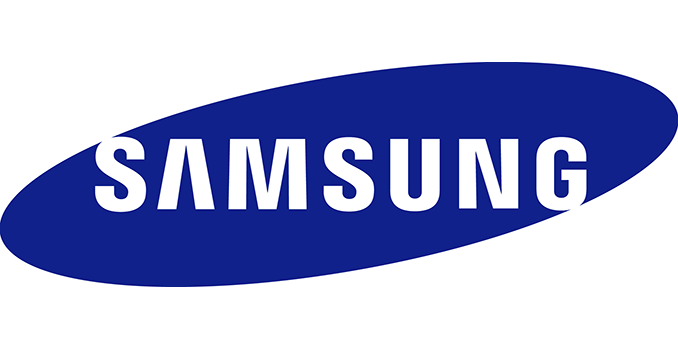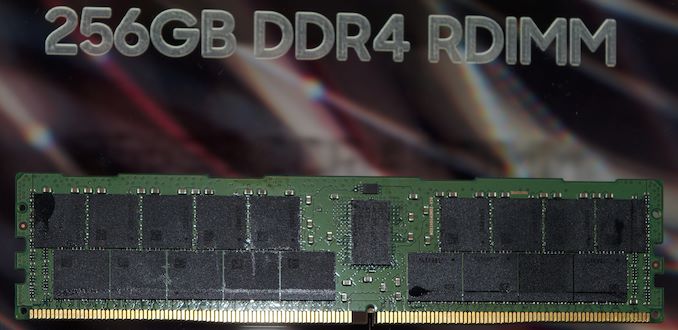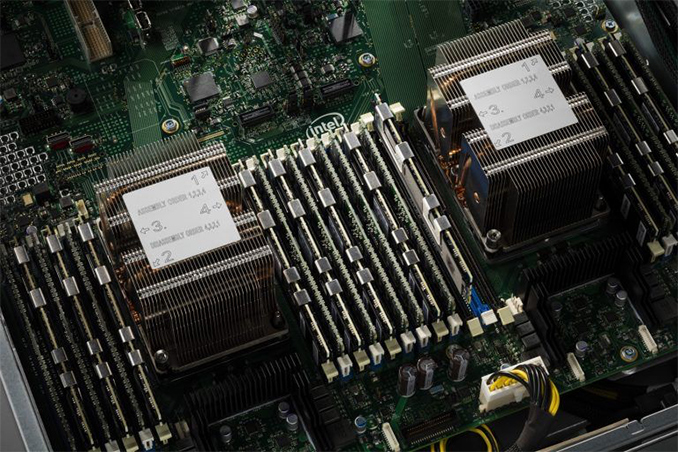Samsung Shows Off 256 GB DDR4 RDIMM: Coming to Servers Soon
by Anton Shilov on October 19, 2018 12:00 PM EST
Samsung this week demonstrated its first 256 GB memory module for upcoming servers. The new Registered DIMM (RDIMM) is based on Samsung’s 16 Gb DDR4 memory devices introduced earlier this year and takes advantage of the company’s 3DS (three-dimensional stacking) packaging. The new module will offer higher performance and lower power consumption than two 128 GB LRDIMMs used today.
Samsung’s 256 GB DDR4 Registered DIMM with ECC carries 36 memory packages featuring 8 GB (64 Gbit) of capacity each, along with IDT’s 4RCD0229K register chip (to buffer address and command signals and increase the number of ranks supported by a memory channel). The packages are based on four single-die 16 Gb components that are interconnected using through-silicon vias (TSVs). Architecturally, the 256 GB module is octal ranked as it features two physical ranks and four logical ranks.
On a bit more of a technical note here, it's very interesting to point out that these new DIMMs are Registered DIMMs (RDIMMs) and not Load-Reduced DIMMs (LRDIMMs). Normally, LRDIMMs are required for high capacity configurations, with these style DIMMs relying on additional buffering that hurts power consumption and latency versus RDIMMs. Instead, because the latest server platforms (AMD EPYC, Intel Xeon Scalable, etc.) have shifted their memory requirements to natively support support octal-ranked modules in both slots - at the cost of being limited to two slots per channel in total - LRDIMMs are not necessary to maximize the memory capacities of these new servers. As a result, simpler RDIMMs can be used instead. I suspect this is a big reason why Samsung decided to go with a 256 GB RDIMMs, as they are a natural pairing with the latest servers.
So what can you do with 256 GB memory modules? Intel’s upcoming Xeon Scalable “Cascade Lake” processors appear to support up to 3.84 TB of memory across all 12 DIMM slots, so by installing 12 256 GB RDIMMs, a dual-socket server could get 6 TB of memory. AMD’s existing EPYC processors officially support up to 128 GB LRDIMM memory modules and up to 2 TB of memory in total, which is logical as AMD has not yet validated 256 GB RDIMMs. If AMD finds 256 GB RDIMMs viable for its platform, it can support them by adjusting microcode of its existing EPYC processors, or just validating them with its upcoming 7nm EPYC "Rome" CPUs. In any case, 256 GB modules can enable up to 4 TB of memory per socket and up to 8 TB of RAM per 2P box in case of the AMD server platform.
Besides capacity and lower latencies when compared to LRDIMMs, a single 256 GB RDIMM will also offer considerably lower power consumption than two 128 GB LRDIMMs used today. This is partly because Samsung uses its 16 Gb memory devices made using its 10nm-class process technology, and partly because it does not use power-hungry iMB and accompanying ICs.
Samsung did not disclose precise specs of its 256 GB RDIMM, but do not expect its frequency to be significantly higher than the currently common DDR4-2400 & DDR4-2667 speeds. Availability of the modules will in turn depend on validation by CPU designers and server makers, which will take some time. Samsung also isn't likely to ever publish an official MSRP for the DIMMs since they're primarily aimed at a very niche market of server operators, but just to add some context, Crucial sells its 128 GB LRDIMMs for $3,300 today, so higher-capacity modules will be priced higher still.
Related Reading:












17 Comments
View All Comments
iwod - Saturday, October 20, 2018 - link
Sigh, when are we going to get cheaper memory?yuhong - Sunday, October 21, 2018 - link
It must get cheaper for 16Gbit DDR4 to catch on.CrazyElf - Sunday, October 21, 2018 - link
Possibly once China begins large scale production of DRAM. NAND prices might fall even more if that happens as well.rpg1966 - Sunday, October 21, 2018 - link
Why are the recent dual-height DIMMs required, when the chips can be packed as efficiently as these into what appears to be a much lower height?zepi - Sunday, October 21, 2018 - link
When memory channel is 64bits wide using differential signaling the pcb designer must keep wire lengths identical within few millimeters for 128 lines. Half of which are coming much closer to memory socket than the other half.End result is that the wires that leave from the ”bottom” of the chip need to do extra curves to have roughly same electrical distance. This requires space on pcb. Or additional layers, which cost money.
rpg1966 - Monday, October 22, 2018 - link
Thanks zepi. Compared to those DIMMs, what's different about these 256GB RDIMMs - the bus width, the number of lines, the signalling type...?abufrejoval - Sunday, October 21, 2018 - link
At those sizes RAM certainly seems to eat more of the invest than CPUs, but I wonder if that's also true for energy consumption: Just how much engineering goes into "energy proportional RAM usage"melgross - Sunday, October 21, 2018 - link
Memory is cheaper. But capacities also go up. Geeze, I remember when one 1K board of RAM for my S-100 buss computer cost close to $400 (in 1976 dollars!). How much would 256GB RAM cost at that price?Chaotic42 - Sunday, October 21, 2018 - link
$102.4 Billion, though I'm guessing you could get a volume discount.rpg1966 - Monday, October 22, 2018 - link
I had an S-100 box connected to my Exidy Sorcerer. Those were the days!